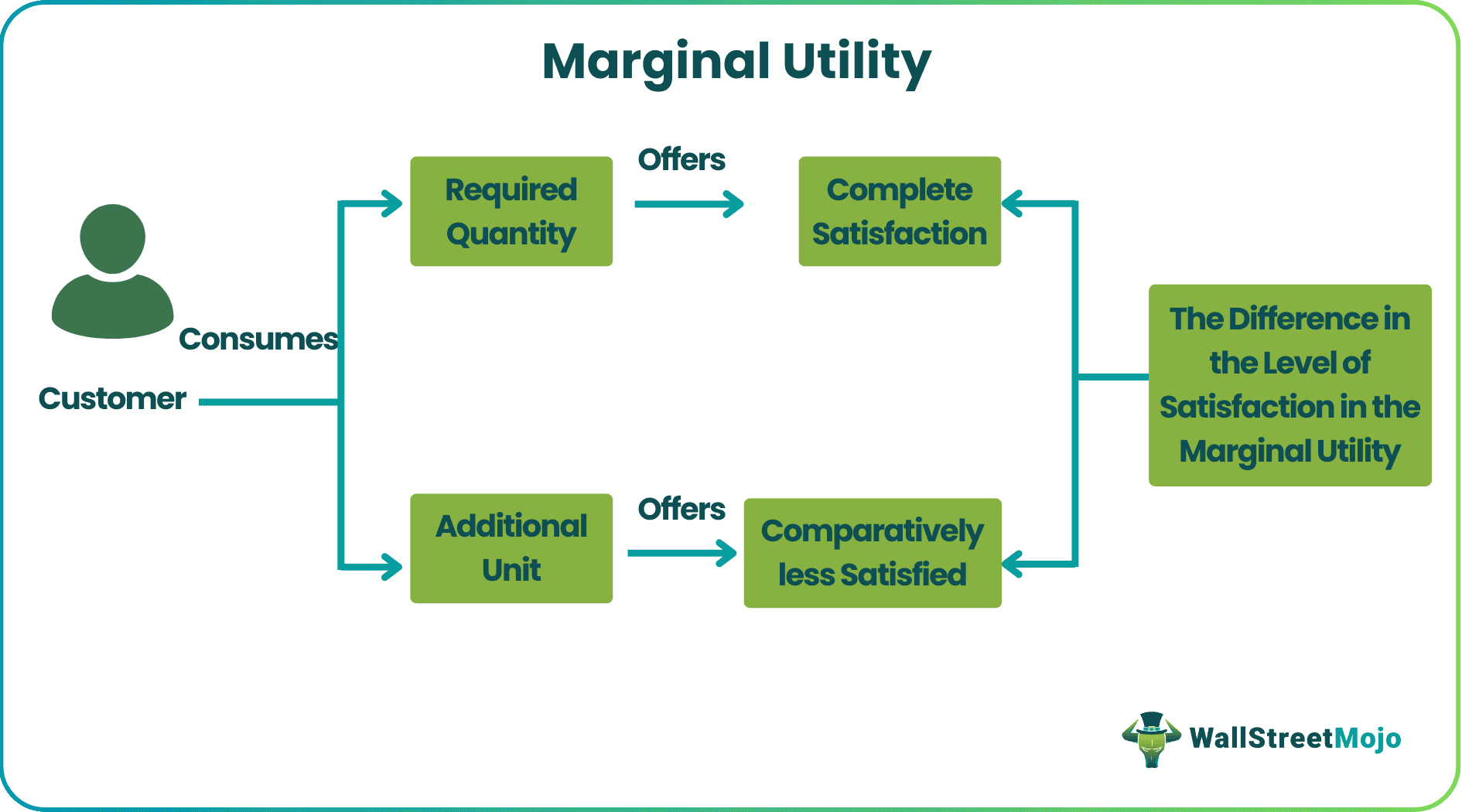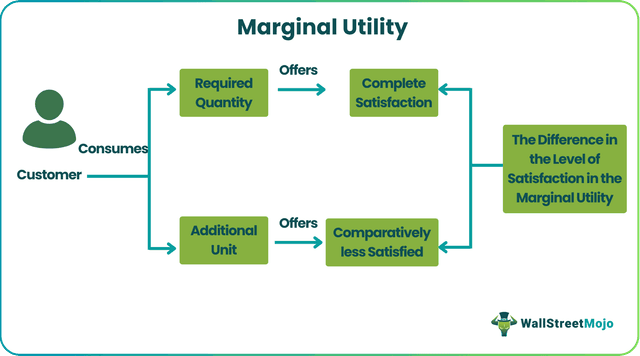Table Of Contents
Key Takeaways
- Marginal utility is the satisfaction level derived when additional units of a product/service are consumed.
- The law of diminishing marginal utility states that the satisfaction level decreases with the increase in the unit of a product/service consumed. It was first proposed by the German economist H.H. Gossen in the 19th century.
- The law, however, has some exceptions, including durable goods, dissimilar products, addictions, etc.
- Calculating the utility level helps firms increase or decrease sales by identifying the most preferred products in the market.
Marginal Utility Meaning
Marginal utility defines the level of satisfaction gained from consuming one additional unit of a particular product or service. Calculating the marginal amount of utility helps companies and firms be aware of the effectiveness of their products/services in satisfying consumers when they purchase and consume them for the second time.

While utility marks the overall level of satisfaction that consumers achieve when they consume only the required amount of a product or service, marginal utility identifies how much more satisfaction another unit of that product or service provides to a consumer.
Marginal Utility Explained
Marginal utility (MU) helps companies determine how likely the consumers are to repeat the same products or services for consumption. This, in turn, lets them decide how much to focus on the existing set of customers and what efforts to put into making them achieve the same level of satisfaction. In short, MU indicates the possibilities of customer retention for a brand.
Calculating the MU level allows companies to understand their customer retention capabilities, but the law of diminishing marginal utility has a different side to the concept. According to this marginal utility theory, the level of satisfaction of consumers reduces with every unit of the same product or service they consume or use.
For the MU to be calculated accurately, the consumed goods must be similar or alike with respect to their size, shape, and composition.
Influential Factors
Multiple factors influence the utility of a product or service. However, the most significant one is the time and first use. The level of satisfaction is determined by a product's ability to satiate consumers' desires. A person who likes to have product A in the afternoon may not prefer it in the evening, which makes a big difference.

When one feels lonely, online games help them get rid of their loneliness. However, when friends surround the same person, dance floors seem more attractive than online games. The same applies to other products as well. Anything available at the right time gains attention and offers complete satisfaction.
The first use is the next thing that influences the level of satisfaction. When one is hungry, the one unit of food received becomes the most satisfactory portion while the next consecutive units become less satisfactory.
Types
The marginal utility can be classified into three broad categories:

- When the additional units of consumption add to the level of satisfaction to consumers, it indicates positive MU.
- If consuming the second or consecutive units of products/services does not make any difference to the satisfaction level of consumers, the marginal amount of utility is said to be zero.
- When consuming the extra units of products diminishes customers' level of satisfaction, it is a sign of negative MU.
Marginal Utility Formula
The marginal utility formula used to calculate the level of satisfaction of consumers is:

The changes in the units can be calculated by subtracting the current units from the previous units of utility level and consumption.
Examples
Let us consider the following marginal utility examples to understand the concept well:
Example #1
When people are thirsty, the highest level of satisfaction they gain is from the first glass of water or juice they consume. However, as they proceed to the glass of water or juice for the second time, it is less satisfying as they are not as thirsty as they were before having the first glass of water/juice. Thus, their urge to consume it reduces with every additional glass.
On the other hand, if it's alcohol addiction, the consumer will want more and more bottles of the drink to satiate the thirst. Hence, the type of product and the purpose behind consuming it is an important factor.
Example #2
Let us consider the following details, specifying the number of units of ice cream consumed and the total utility offered along with the MU calculated using the above formula:
| Units | Total Utility | Marginal Utility |
|---|---|---|
| 1 | 10 | 10 |
| 2 | 19 | 9 |
| 3 | 27 | 8 |
| 4 | 22 | 5 |
| 5 | 20 | 2 |
| 6 | 19 | 1 |
Here is the graphical representation of the level of satisfaction:

As observed from the above graph, there is a fall in the marginal value, which justifies the diminishing marginal utility law.
Applicability
The calculated marginal amount of utility can be utilized in many ways. Here is a list of some of them:
- The diminishing utility theory is the main concept driving the progressive tax system, which states the ones with lower income should pay lower taxes.
- The products with higher MU would be the first preference of consumers as they would never waste their expenditure on something that wouldn't meet their expectations in the long run.
- Based on this utility of a product, the prices are determined. For example, products offering higher satisfaction with time and after first use are priced high for more profits.
- It becomes a guide to improving customer retention for brands as the latter comes to know how to upgrade and keep up the product or services to ensure customer satisfaction.
- This, in turn, guarantees customers’ loyalty to the brands and makes sure their word-of-mouth reference brings a new set of consumers and helps brands create a stronger customer base.
Marginal Utility vs Total Utility
Marginal utility and total utility are the two common terms used to compute the satisfaction level of consumers when they pay for a product/service. Let us check out the differences between the two:
Total utility is the total satisfaction that consumers get from consuming a product or using a service. On the other hand, MU is the amount of satisfaction that each unit of the product consumed offers to customers.
The total utility of a product keeps rising with time, while MU decreases with the increase in the units consumed.

